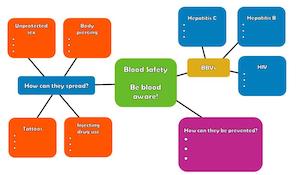- Ask students: what do you think the acronym BBV stands for? Take answers (some answers may be humorous and that's ok)
- Say:
"BBV stands for blood-borne virus. BBVs are transmitted from person to person through blood to blood contact, for example HIV and hepatitis C. We're going to start with a true or false quiz to see what you already know about BBVs. By the end of the lesson you will have the information to answer all the questions correctly, but for now the quiz is purely for you to assess your own pre existing knowledge."
- Ask students write 1-10 on a piece of scrap paper. Tell students that they do not have to reveal their answers or put their names on the sheet, and that they can throw the sheet in the bin when complete. The quiz is for their own learning and refection.
- Ask students each of the 10 True or False questions in Teacher resource: Blood-borne virus quiz and answer sheet. As each question is asked, wait for students to write T or F and then give the answer only as True or False explaining that students will find out the reasons for the answers by the end of the lesson.
- Watch the Laugh and learn video - blood-borne virus safety (1min 46sec).

- Ask:
Why do you think humour is used? What do you think of the use of humour?
(e.g. lots of people have negative thoughts and myths about BBVs; break the ice/tension of a serious topic; issues like BBVs can be sensitve and embarrassing, and people use humour to cope with their embarrassment and/or lack of knowledge)
Does it help get information across? How?
What is the message/information you got from this video?
(e.g. BBvs can be transmitted through tattoos, piercings, needles and unprotected sex; some BBVs can also be sexually transmitted; chlamydia is not a BBV; to prevent BBVs, avoid blood to blood contact)
- Provide access to the Blood Aware animation for the whole class. This click through animation should take approximately 2-3 minutes to read.
- Ask:
What new piece of information did you learn from that animation?
(e.g. Blood cannot enter the body through the skin; blood can carry viruses such as HIV and hep C; blood can only enter the body through a break in the skin or lining of the mouth, vagina, penis or anus; once inside the break in the skin, it can mix with the blood and may result in the transfer of a virus; the ways that you can come into contact with someone else's blood include: unsafe injecting drug use, unsterile tattooing equipment, not using condoms when having sex, sharing razors and toothbrushes, needlestick injury, unsterile body piercing; blood particles can be too small to see without magnification (so you may not see the blood)).
- Explain:
Virus present + body fluid (e.g. blood) + activity (e.g. unsterile body piercing) + point of entry (e.g. broken skin) = risk
"Blood can also carry the hep B virus. Some BBVs (HIV and hep B) are also transmitted through other body fluids (semen and vaginal fluids) which is also why condoms need to be used. People can come into contact with someone else's blood in other ways such as sporting injuries which is why it is important to let an adult know if someone is bleeding, following the sports blood rule and appropriate first aid procedures."
- Divide the class into groups of 4. Each group will need access to the website getthefacts.health.wa.gov.au/bloodsafe as a reliable source of information for the activity.
- Ask:
Why do you think you have been given this website Get the Facts and not asked to search for your own information?
(Anyone can write anything online and when looking for health information it is important to check who is writing material and that it comes from a reliable and credible source and is up to date and relevant to Western Australia (as laws, services, etc can differ from state to state and country to country). The Get the Facts website is written by WA Department of Health and aims to provide accurate and reliable information on sexual health, blood-borne viruses and relationships for young people in Western Australia. Its specific target group is 13-17 year old people. It is regularly updated to maintain current information.)
- Give each group 10 minutes to research answers to one of the following questions on the Get the Facts website.
- Ask each group to write what they think are the 5 most important pieces of information that all people should know about their topic.
- What are BBVs - hep B?
- What are BBVs - hep C?
- What are BBVs - HIV/AIDS?
- How can BBVs be spread? Unprotected sex
- How can BBVs be spread? Body piercings
- How can BBVs be spread? Body tattoos
- How can BBVs be spread? Injecting drug use
- How can BBVs be prevented?
- Have each group report their findings to the whole class.
Suggestions for class reporting
- Complete student activity sheet to be combined into a display about being Blood Aware (See example Teacher resource: BBV safety_example of display).








